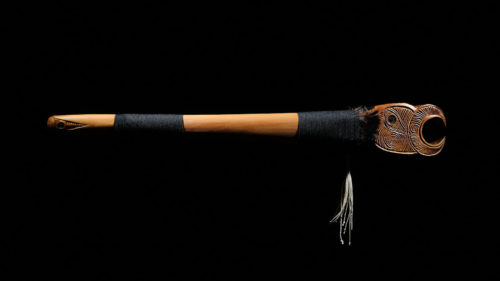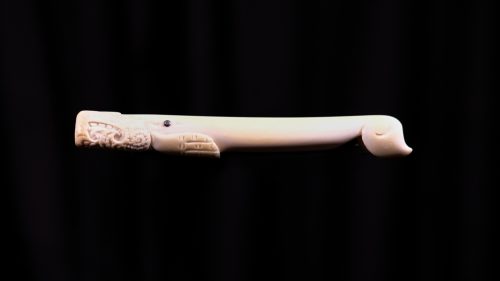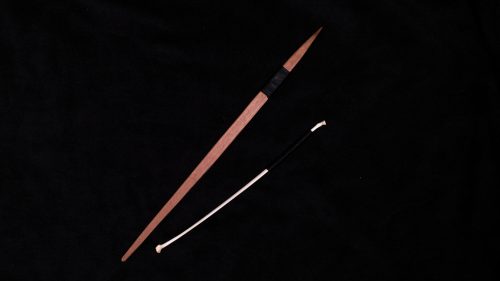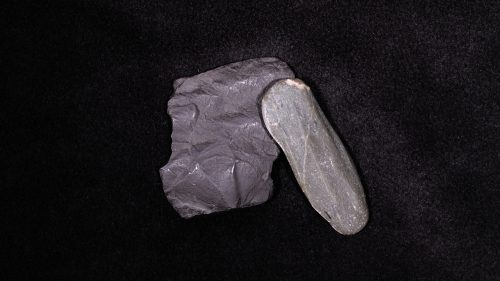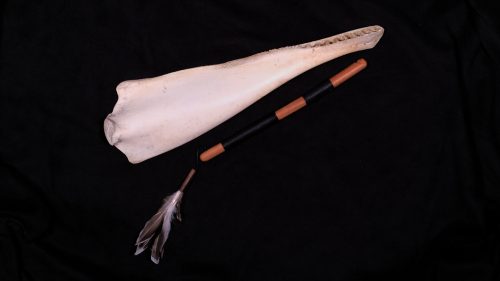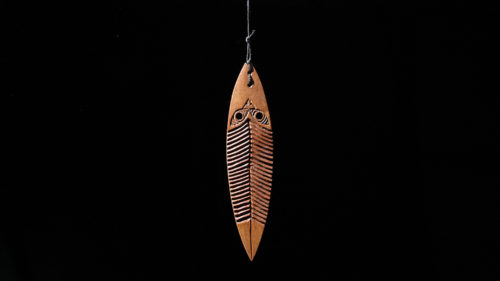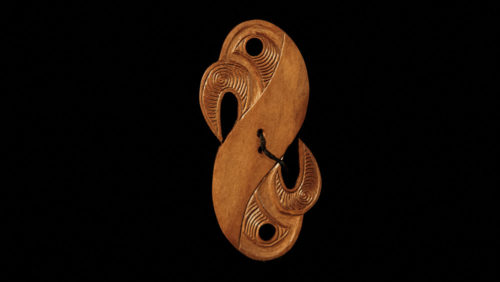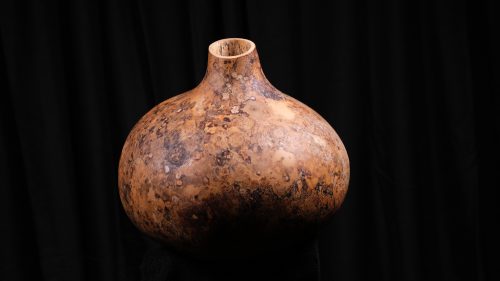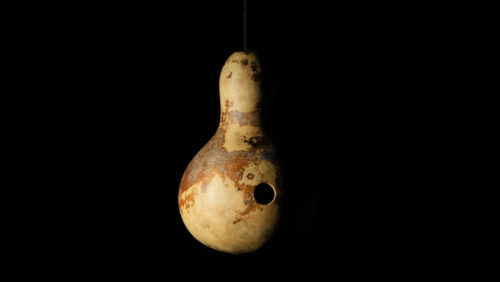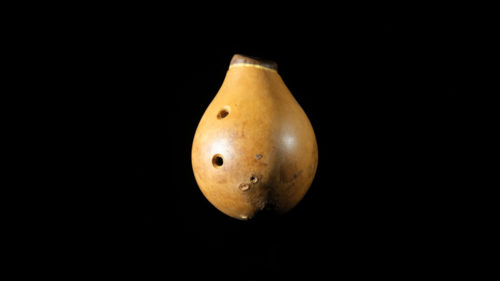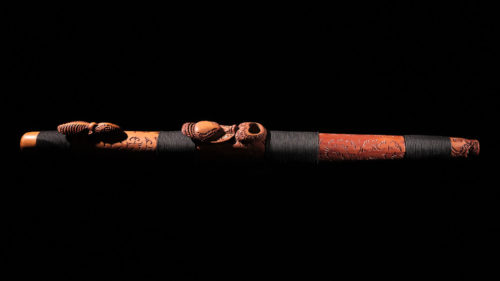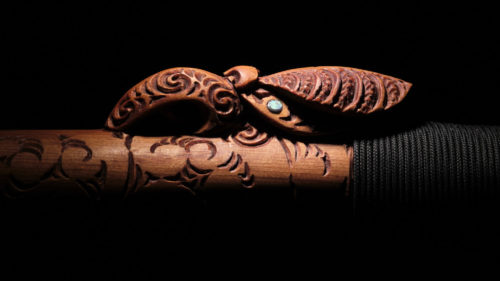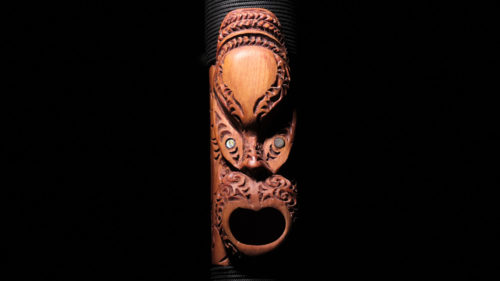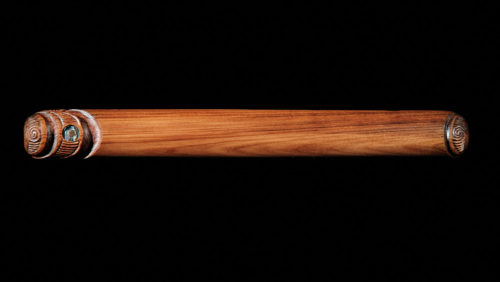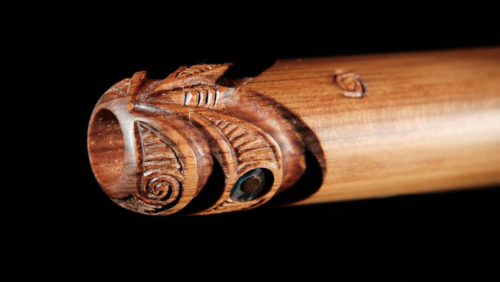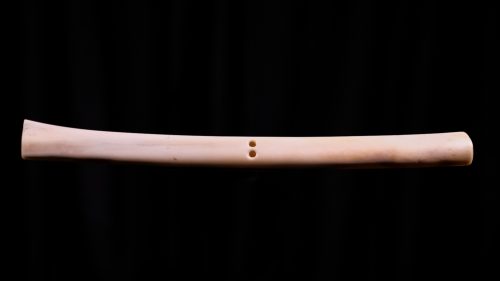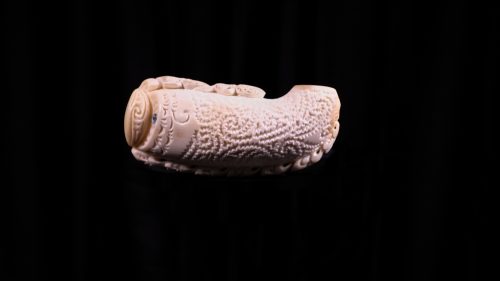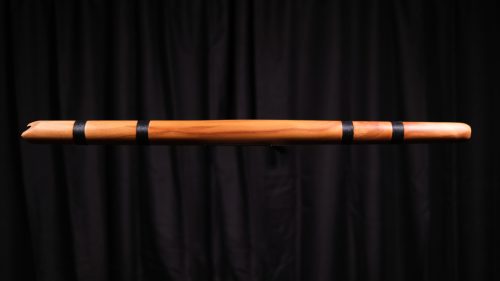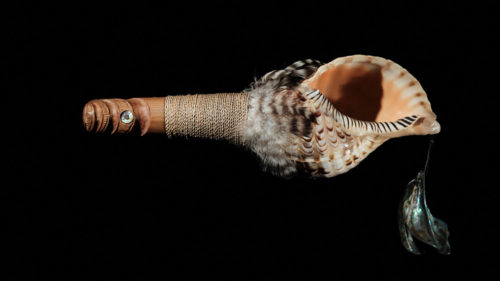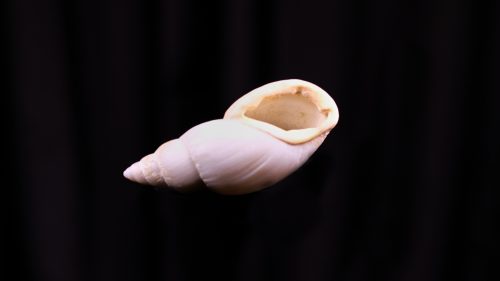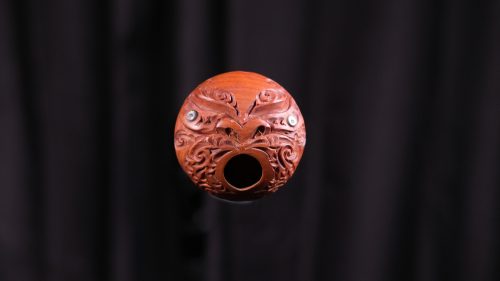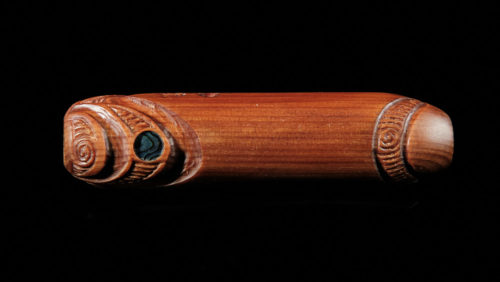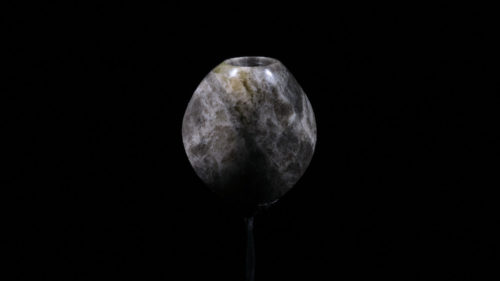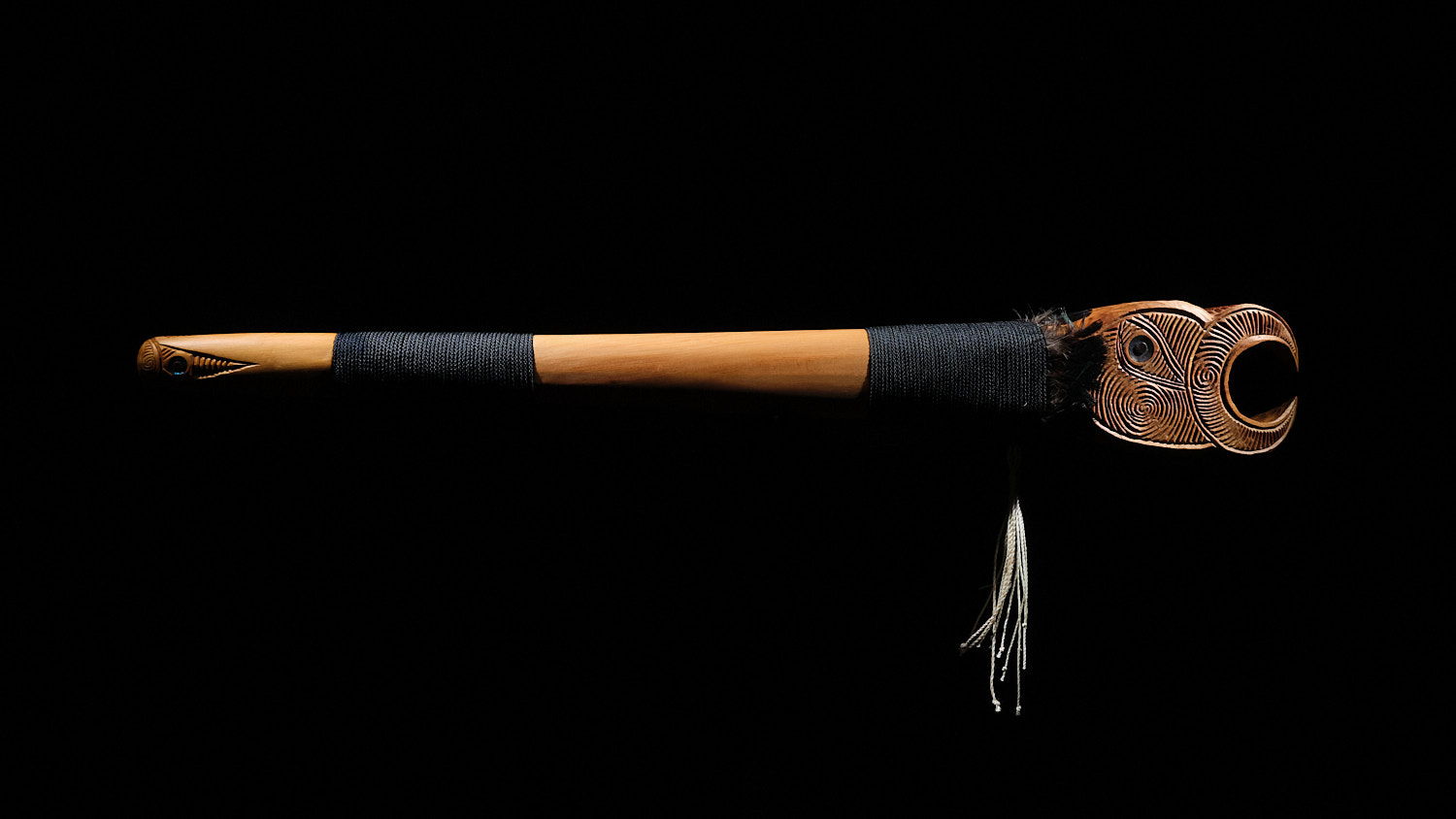
Te Ao o Taonga Puoro - Programme Content
This page details the content of Bob's school programme, Te Ao o Taonga Puoro, and is designed to be a reference resource for teachers.
Translations to Te Reo Māori are shown in italics in brackets after the phrase/word.
The live presentation may vary dependent on the age of students and whether they are learning in a kaupapa Māori environment.
Click on the images in the side column to view a larger image.
Click the link below to download a printable PDF of this page:
Mihi Whakatau
The Pūkāea is often used to announce events and so it is here! Bob will either mihi students and teachers with a simple kia ora or may use elements of the following:
Pepeha
E ngā tamariki, tēnā koutou, e te/ngā kaiako, tēnā koe/kōrua/koutou.
No Birmingham ahau, engari, i haere mai ahau ki Aotearoa i te wā o tōku taitamarikitanga, no reira ko Whakatū tōku kainga inaianei. Ko Bob Bickerton tōku ingoa.
Kua whakamānawa ahau ki te tū i runga i tenei whenua. Kei te whakamihi ahau. Nōku waimarie, nōku waimarie, nōku waimarie.
(I acknowledge the children and the teacher/s. I am from Birmingham, however, I travelled to Aotearoa when I was a teenager and so Nelson is now my home. My name is Bob Bickerton. I feel blessed to stand on this land. I am grateful. I am fortunate.)
Karakia - I mua
Kia tau ai o tātou ngākau.
Kia rukuhia ngā oro o Hine-pū-te-hue, o Hine-Raukatauri te ao taonga puoro.
Whakarongo ki te reo o ngā atua!
Whakarongo ki te puoro o ngā tīpuna!
Whakarongo ki te hā o te ao tūroa!
Tiakina ngā oro o te ao Māori!
Tīhei Mauri Ora!
(Let us settle our hearts as we dive into the sounds of Hine Pū Te Hue and Hine Raukatauri, into the world of taonga pūoro.
Listen to the language of the gods!
Listen to the music of the ancestors!
Listen to the sounds of the natural world!
Preserve the sounds of the Māori world!
Let it be so!)
Introduction
Taonga Pūoro are the wonderful instruments that were played by the Māori people long ago.
Until recently they lay silent in museums because people had forgotten how to make them. They had forgotten how to the play them.
One day someone called Hirini Melbourne was looking at the instruments in a museum and he felt sad and he wondered what their voices sounded like, so he formed a group with Richard Nunns and Brian Flintoff, as well as others, to revive the instruments, to bring them back to life. They called themselves Haumanu - breath of birds - which also means to ‘revive’.
The instruments are members of whānau (families) just like us and they whakapapa back to (are descended from) the atua (gods).
We’ll use pūrākau (old stories) to explore the instruments. You may have different versions of the stories - which is fine - as they’re all part of the rich tapestry of stories that describe the world in which we live.
A Creation Pūrākau
This story is told using a kōauau accompaniment.
In the beginning there was Te Kore (nothing) - not even darkness - and so the atua (gods) decided to create the world in which we live.
How did they do it? They sang the world into existence using a kōauau.
After many thousands of years there came Te Pō (the night), then many thousands of years later came Te Pō Roa (the long night), then Te Pō Nui (the big night). Finally there, in the distance, came a light, Te Haeata (the dawn) and from that came Te Ao Marama (the world of light), the world in which we live in today.
And all this was done with the simple kōauau - cool eh?
A Separation Pūrākau
This story features the instruments of the Papatūānuku whānau.
Ranginui, the sky father and Papatūānuku, the earth mother, lay together in an eternal embrace and they had lots and lots of children. But after many years the children became restless and were fed up with having to live between their parents - they were really squashed! Can you imagine what that’s like? In fact one of the best places to hang out was in their armpits - it was a bit smelly, but at least there was more space!
In the end most of the children decided they wanted to separate their parents so as to bring light into their world and it was Tāne who lay on his back and, with his strong legs, pushed them apart.
But Ranginui and Papatūānuku were very sad to be separated. Ranginui’s tears fell as tōuarangi (rain) and Papatūānuku’s tears rose as kohu (mist) - the pākuru is played.
And so it was that the children turned Papatūānuku over so that Rangi and Papa wouldn’t have to look at each other and be so sad - the kōhatu is played.
Now when Papatūānuku was turned over, she had a pēpē (baby) in her puku (belly) and his name was Ruamoko and he became the atua of earthquakes - the tumutumu is played.
This tumutumu is made from the jaw bone of a whale. In fact any instrument that you hit can be a tumutumu and you could find your own. It could be two sticks, or two pieces of stone or like this, made from bone.
It’s said that in the olden days the tumutumu was used to help people to learn words. It is said it was like the sound of the carver’s chisel and it would carve the words into the mind of the listener.
Tāwhirimātea
Not everyone was happy with the separation of Rangi and Papa, in fact Tāwhirimātea (the god of the winds) was so angry that he tore out his eyes and threw them up into the sky - and they became the star cluster of Matariki - the pūrerehua is played.
But the wind isn’t always strong and stormy, it can also be soothing and this instrument of the Tāwhirimātea whānau is very gentle indeed - the porotiti is played.
The porotiti was used to help people who had a really bad cold as its vibrations would ease congestion. Also the old people would play the instruments as it was a good exercise for their hands if they had arthritis.
Hine Pū Te Hue
It was Hine Pū Te Hue, the goddess of hue (gourds) who finally brought peace to her siblings. She took their anger into herself - the Hue Puruhau is played.
And when peace returned she kept the anger from escaping - place cork in hue.
Here’s two other instruments that are part of the Hine Pū Te Hue whānau and they’re both peaceful sounding.
We have the Poi Awhiowhio - the Poi Awhiowhio is played.
And this one is played - not with the mouth - but with the nose - the kōauau ponga ihu is played.
Hine Raukatauri
Hine Raukatauri was the goddess of flute music and she loved her flute so much that she went to live inside it! Finally she became the New Zealand Case Moth and next time you’re in the playground you could look out for her. She is shaped like this, but about this long - holding the pūtōrino and demonstrating actual size - and you might find her hanging from the branch of a tree.
It is said that the kōkako has the purest song of any bird in the world - and where does it get its beautiful song from? Well, it eats the Case Moth - it eats Hine Raukatauri!
Now this instrument tells the story of Hine Raukatauri. You can see a carving of the kōkako here - and this is Hine Raukatauri - and this is the case moth.
The pūtōrino has many voices. It has a tāne (male) voice - the pūtōrino is played - two wāhine (female) voices - the pūtōrino is played - and if you’re lucky you’ll be able to hear the child’s voice. If you can hear it, it’ll be like little high-pitched icicles of sound - the pūtōrino is played. In fact if you make that sound louder it sounds just like a dawn chorus of birds!
We heard the kōauau at the beginning, but they can come in different sizes. This one is longer and so it is lower in pitch and sometimes these long ones are called pōrutu - the pōrutu is played.
Let’s look at the carving on this instrument. Can you see there’s a face at the blowing end? There’s the eyes, and there’s the nose and the mouth is the hole at the end. The reason there’s a face on the instrument is that, it is a sort of ‘person’ instrument and we have to work as a team to make the sound. You see I can’t make the sound without the instrument and the instrument can’t make the sound without me. So what do we do? We hongi, greet each other and share our breath. Cool eh?
You can make your own kōauau out of bamboo. Maybe you could try that sometime.
This instrument is made from bone and is called an ororuarangi. It’s the wing bone from a bird - can you guess what bird it might be? Yes the toroa (albatross) and as I play it you might like to imagine that this bone may have travelled around the world many times inside an albatross’s wing - the ororuarangi is played.
This instrument is made from the tooth of a tohorā! (whale) It’s called a nguru and there’s a story behind this particular nguru.
You may recall I mentioned someone called Hirini Melbourne before. Well he was visiting Farewell Spit (in Golden Bay) one day and he decided to use this instrument to play to the whales - the pūtātara is played.
Three days later, three sperm whales beached themselves at that point on the spit and unfortunately they died. Believe it or not, this is one of the teeth from one of those whales - the nguru is played.
The pūmotomoto is a very special instrument. It is said that it was used to impart whakapapa (ancestry) knowledge into babies, both in the womb and when newly born. In fact the te reo Māori word for the fontanelle is pūmotomoto. This indentation on the top of the head is soft in new born babies and it was thought information could be transmitted directly to the baby’s mind through the pūmotomoto - the pūmotomoto is played.
Tangaroa
We heard the pūtatara just now and because it is made from a shell, it’s part of the Tangaroa, the god of the sea’s, whānau. Some people reckon they can hear the sea when they put the shell up to their ears - could I have a volunteer please - (shell on ear skit).
So the pūtātara has both the tāne (male) voice - the pūtātara is played - and a wāhine (female) voice - the pūtātara is played.
This small shell is from the pūpū harakeke, a snail that lives on the harakeke plant. There’s a story from the North Island that says that people used to listen out for the pūpū harakeke at night because it would whistle when it rushed back into its shell. Sometimes if an enemy was approaching, people would hear the pūpū harakeke and know there was danger around! The pūpū harakeke is played.
Tāne
As well separating his parents, Tāne undertook many tasks and one of them was clothing Papatūānuku in beautiful ngahere (forests) and manu (birds).
Here are some instruments that make the sounds of Tāne’s manu - see if you can guess what bird they are:
The Karanga Ruru is played.
The Karanga Weka is played.
The Karanga Manu is played.
Also the instrument we heard at the beginning of the show also belongs to Tāne - the pūkāea - the pūkāea is played.
Conclusion
So that just about brings us to the end of the show, but I’d like to finish up with a waiata and karakia. In this waiata you hear how one of these instruments can be used to accompany a song.
Waiata:
Whakarongo mai, tūī,
i taku kōauau, tūī,
e taku waiata, tūī,
tūi, tūīa
(Listen to my kōauau, to my song, let us bind together.)
Karakia - E muri:
Kia pāorooro ēnei taonga whakatangitangi,
Kia puta ki te whaiao, ki te ao mārama,
Haumi e, hui e, taiki e
(Let the sounds of these treasured instruments go into the world, the world of light, join together, bind together, let it be done)
